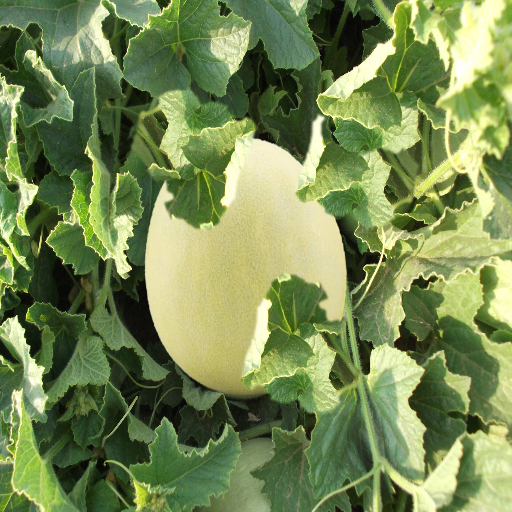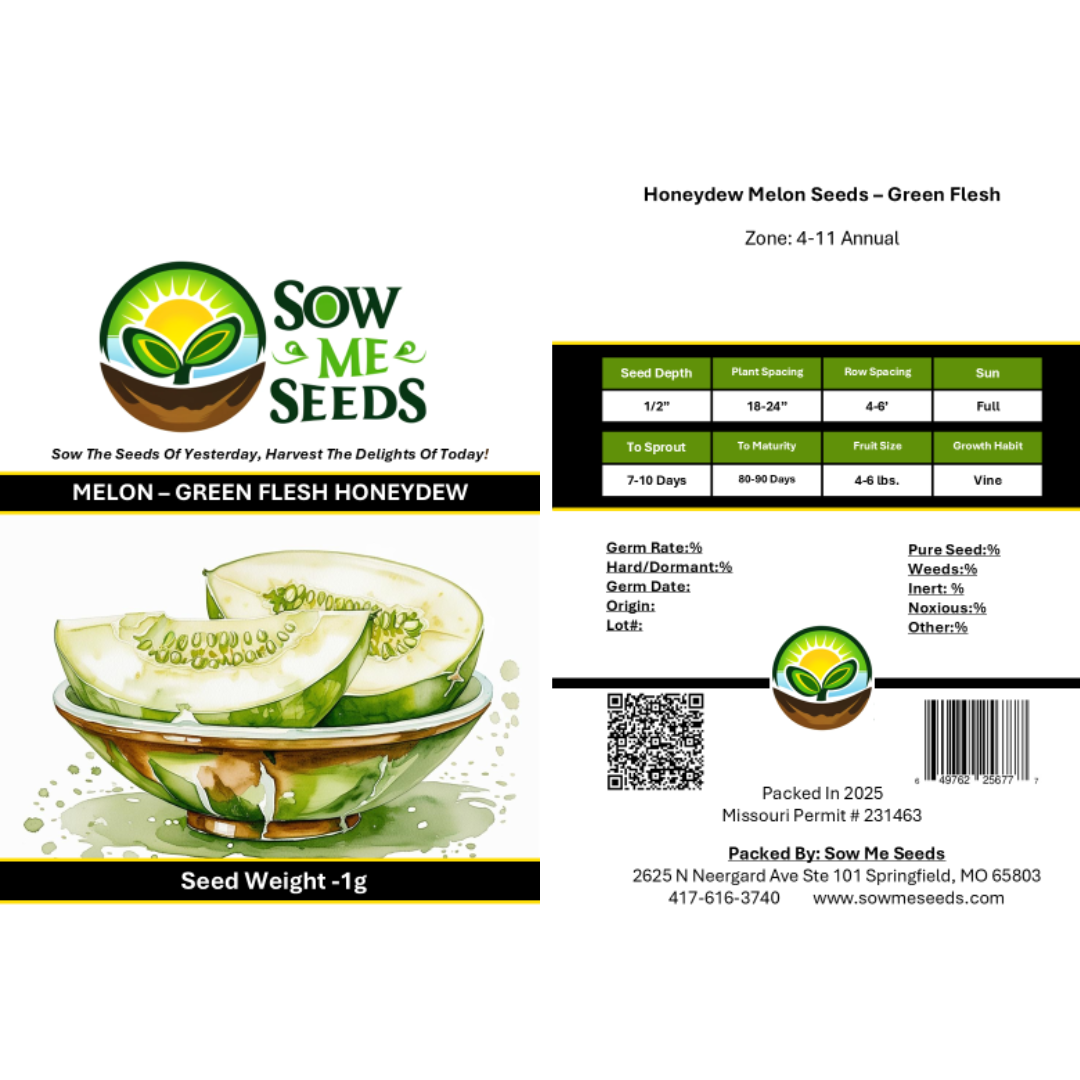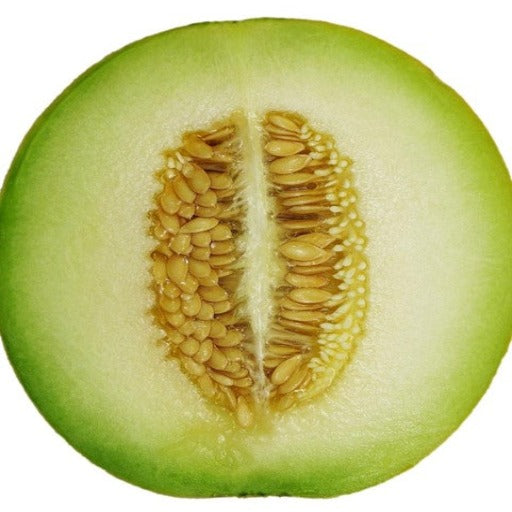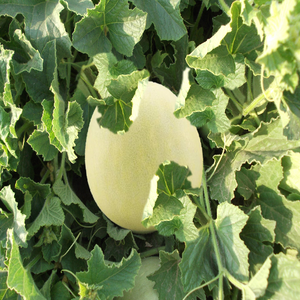- Hardiness Zone: 4-11 Annual
Seed Depth: 1/2–1 inch
Seed Spacing: 24–36 inches
Row Spacing: 5–6 feet
Sunlight: Full sun
Days to Sprout: 7–14 days
Days to Maturity: 85–95 days
Growth Habit: Sprawling Vine
Sunlight:Choose a location that receives full sun for at least 6-8 hours a day. Melons thrive in warm, sunny conditions.
Soil:Prefers well-drained, sandy or loamy soil with a pH between 6.0 and 6.8. Amend the soil with compost or well-rotted manure to enhance fertility and drainage.
When to Plant: Honeydew melons are warm-season crops that should be planted after the danger of frost has passed and the soil has warmed to at least 70°F (21°C). In cooler climates, start seeds indoors 3-4 weeks before the last expected frost date.
Starting Indoors: Sow seeds 1/2 inch deep in seed-starting mix. Keep the soil moist and maintain a temperature of 75-85°F (24-29°C). Transplant seedlings outdoors when they have 2-3 true leaves and all danger of frost has passed.
Direct Sowing: In warm climates, seeds can be sown directly in the garden once the soil has warmed. Sow seeds 1/2 inch deep in hills spaced 3-4 feet apart. Plant 3-4 seeds per hill and thin to the strongest seedlings once they are a few inches tall.
Succession Planting: Stagger plantings every 2–3 weeks to enjoy a continuous harvest.
Watering: Keep the soil consistently moist but not waterlogged. Water melons regularly, especially during dry periods. Reduce watering as the fruits mature to enhance sweetness. Mulch around the plants to retain soil moisture and suppress weeds.
Fertilization: Melons are heavy feeders. Apply a balanced fertilizer or compost at planting time. Side-dress with compost or a balanced fertilizer every 3-4 weeks during the growing season. Reduce nitrogen levels as fruits begin to form to encourage fruit development over foliage growth.
Mulching and Weeding: Apply a layer of mulch around the plants to retain soil moisture, suppress weeds, and keep the soil temperature consistent. Hand-pull weeds carefully to avoid disturbing the shallow roots of the melons.
Training and Pruning: Train melon vines to grow on a trellis or along the ground. If growing on a trellis, support the developing fruits with slings made of fabric or netting. Pinch off the growing tips of the main vines after they have set 4-6 fruits to encourage the plant’s energy to go into fruit production.
Pest and Disease Management: Melons can be susceptible to pests such as cucumber beetles, aphids, and spider mites. Use organic pest control methods like neem oil, insecticidal soap, or hand-picking to manage infestations. Practice crop rotation and ensure good air circulation to prevent fungal diseases like powdery mildew and downy mildew.
When to Harvest: Honeydew melons are typically ready to harvest 80-100 days after planting. Harvest when the skin turns from green to a creamy yellow and the melon emits a sweet fragrance. The blossom end should give slightly when pressed.
How to Harvest: Use a sharp knife or pruning shears to cut the melon from the vine, leaving a short stem attached. Handle the fruits gently to avoid bruising.
Storing Fresh Melons: Freshly harvested melons can be stored at room temperature for a few days or in the refrigerator for up to a week. Once cut, store the melon in an airtight container in the refrigerator for up to three days.
Why You’ll Love It
Cool & Refreshing: Crisp, juicy green flesh with mellow sweetness.
Smooth-Rinded Beauty: Pale, creamy outer skin develops subtle golden tones when ripe.
Heat-Loving Producer: Performs best in hot, dry climates with full sun.
Long Shelf Life: Keeps well after harvest — ideal for markets or extended enjoyment.
Plant Characteristics
Height: Vining, with long, trailing growth
Growth Habit: Sprawling vines that can be trained on trellises or left to spread
Fruit Type: Round, smooth melons, 3–5 lbs., with creamy rind and light green flesh
Days to Maturity: 90–100 days
Hardiness: Warm-season annual
Flavor and Culinary Uses
Flavor: Mild, floral, and honey-sweet with a refreshing crunch
Culinary Uses: Delicious fresh, in fruit salads, smoothies, or chilled melon bowls
Companion Planting Tips
Good Companions: Corn, nasturtiums, marigolds, and basil
Avoid Planting Near: Potatoes or strong-scented herbs like sage and rosemary
Bonus Benefit: Attracts beneficial insects while deterring some garden pests
Common Issues and Solutions
Poor Fruit Set: Ensure proper pollination — attract bees or hand-pollinate if needed
Powdery Mildew: Water at the base and provide good air circulation
Cracked Fruit: Maintain consistent watering as melons mature
Seeds Per Packet
| 1g | Approximately 35 |
| 3g | Approximately 105 |
Why You’ll Love It
Cool & Refreshing: Crisp, juicy green flesh with mellow sweetness.
Smooth-Rinded Beauty: Pale, creamy outer skin develops subtle golden tones when ripe.
Heat-Loving Producer: Performs best in hot, dry climates with full sun.
Long Shelf Life: Keeps well after harvest — ideal for markets or extended enjoyment.
Plant Characteristics
Height: Vining, with long, trailing growth
Growth Habit: Sprawling vines that can be trained on trellises or left to spread
Fruit Type: Round, smooth melons, 3–5 lbs., with creamy rind and light green flesh
Days to Maturity: 90–100 days
Hardiness: Warm-season annual
Flavor and Culinary Uses
Flavor: Mild, floral, and honey-sweet with a refreshing crunch
Culinary Uses: Delicious fresh, in fruit salads, smoothies, or chilled melon bowls
Companion Planting Tips
Good Companions: Corn, nasturtiums, marigolds, and basil
Avoid Planting Near: Potatoes or strong-scented herbs like sage and rosemary
Bonus Benefit: Attracts beneficial insects while deterring some garden pests
Common Issues and Solutions
Poor Fruit Set: Ensure proper pollination — attract bees or hand-pollinate if needed
Powdery Mildew: Water at the base and provide good air circulation
Cracked Fruit: Maintain consistent watering as melons mature
Seeds Per Packet
| 1g | Approximately 35 |
| 3g | Approximately 105 |





Share and get 15% off!
Simply share this product on one of the following social networks and you will unlock 15% off!